View in other NatureServe Network Field Guides
NatureServe
Montana
Utah
Wyoming
Idaho
Wisconsin
British Columbia
South Carolina
Yukon
California
New York
Shoshonea - Shoshonea pulvinata
State Rank Reason (see State Rank above)
Known in Montana only from the Pryor Mountains and the eastern slope of the Beartooth Plateau. Occurrences are located mostly on federal lands.
- Details on Status Ranking and Review
Population Size
Score1 - Moderate: Generally 10,000-100,000 individuals.
CommentAvailable data supports an estimated population size of slightly greater than 10,000 plants.
Range Extent
Score3 - Local Endemic or Very Small Montana Range: Generally restricted to an area <10,000 sq. miles (equivalent to the combined area of Phillips and Valley Counties) or <6 Sub-basins (4th code watersheds) Range-wide OR limited to one Sub-basin in Montana
Area of Occupancy
Score2 - Low: Generally occurring in 4-10 Subwatersheds (6th Code HUC’s).
Environmental Specificity
Score1-2 - Moderate to High.
Trends
Score0-2 - Stable to Moderate Declines:
CommentMonitoring data from the 1990's generally showed stable to slightly declining trends, though increased mortality may have occurred since as a result of drought conditions.
Threats
Score0-1 - Low to Medium.
Intrinsic Vulnerability
Score1-2 - Moderate to High Vulnerability.
Raw Conservation Status Score
Score
8 to 13 total points scored out of a possible 19.
General Description
Shoshonea is a low, mat-forming, herbaceous, long-lived perennial with a woody taproot and branching underground stems. The aboveground stems are 2-8 cm in length and usually clothed at their bases with remnants of the previous year's leaf sheaths. Leaves are ca. 5-25 mm long, 3-20 mm wide, and have a petiole that is ca. half their length. The leaf blades are oddly pinnate with 5-11 divisions and oblong to oval in outline. The leaf petioles are swollen and papery at their bases, and herbage is glabrous to somewhat roughened. The smallest flower clusters consist of a number of stalked flowers attached at a single point (simple umbels); these clusters are, in turn, stalked and attached at the top of the ovary. The fruits are approximately 2-4 mm long, slightly roughened to the touch, and without wings.
Phenology
Flowering late June-July.
Diagnostic Characteristics
In open habitats, this species forms dense cushions and cannot be mistaken for any other member of the Parsley family in our area. In partially shaded sites, the cushion-forming habit is not so strongly expressed, and Shoshonea can be mistaken for species of Musineon, Cymopterus and Lomatium. The sessile flowers and persistent leaf bases are diagnostic. A technical key should be consulted to separate these groups.
Species Range
Montana Range
Range Descriptions
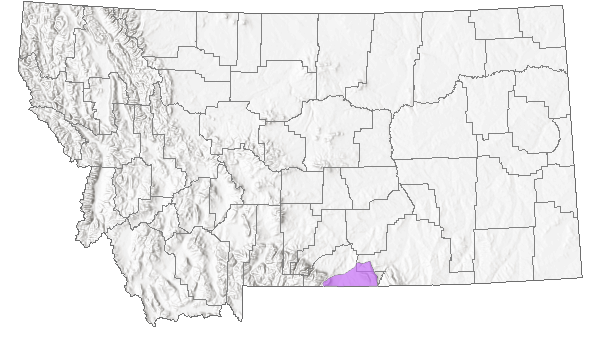
 Native
Native
Range Comments
Regional endemic to the Absaroka and Owl Creek Mountains of northwest Wyoming and adjacent Montana.
Observations in Montana Natural Heritage Program Database
Number of Observations: 68
(Click on the following maps and charts to see full sized version)
Map Help and Descriptions
Relative Density
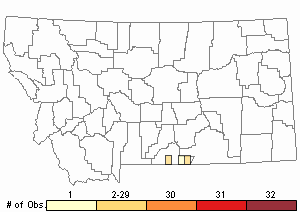
Recency
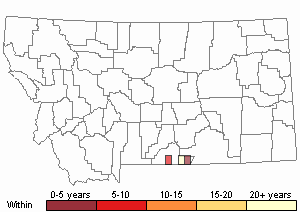
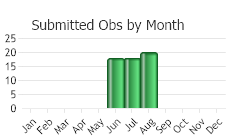
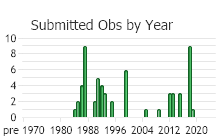
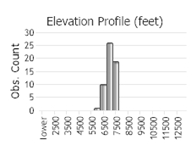 (Observations spanning multiple months or years are excluded from time charts)
(Observations spanning multiple months or years are excluded from time charts)
Habitat
Open, exposed limestone outcrops, ridgetops, and canyon rims, in thin rocky soils.
National Vegetation Classification System Groups Associated with this Species
Forest and Woodland
Low Elevation - Xeric Forest and Woodland
Montane - Subalpine Forest and Woodland
Shrubland
Foothills - Montane Shrubland
Sparse and Barren
Sparse and Barren
Stewardship Responsibility
Threats or Limiting Factors
STATE THREAT SCORE REASON
Threat impact not assigned because threats are not known (MTNHP Threat Assessment 2021).
References
- Literature Cited AboveLegend:
 View Online Publication
View Online Publication MTNHP Threat Assessment. 2021. State Threat Score Assignment and Assessment of Reported Threats from 2006 to 2021 for State-listed Vascular Plants. Botany Program, Montana Natural Heritage Program, Helena, Montana.
MTNHP Threat Assessment. 2021. State Threat Score Assignment and Assessment of Reported Threats from 2006 to 2021 for State-listed Vascular Plants. Botany Program, Montana Natural Heritage Program, Helena, Montana.
- Additional ReferencesLegend:
 View Online Publication
View Online Publication
Do you know of a citation we're missing? Clark, T.W., H.A. Harvey, R.D. Dorn, D.L. Genter, and C. Groves (eds). 1989. Rare, sensitive, and threatened species of the greater Yellowstone ecosystem. Northern Rockies Conservation Cooperative, Montana Natural Heritage Program, The Nature Conservancy, and Mountain West Environmental Services. 153 p.
Clark, T.W., H.A. Harvey, R.D. Dorn, D.L. Genter, and C. Groves (eds). 1989. Rare, sensitive, and threatened species of the greater Yellowstone ecosystem. Northern Rockies Conservation Cooperative, Montana Natural Heritage Program, The Nature Conservancy, and Mountain West Environmental Services. 153 p. Dorn, R.D. 1989. Report on the status of Shoshonea pulvinata, a candidate threatened species. Unpublished report. Mountain West Environmental Services, Cheyenne, WY. 32 pp.
Dorn, R.D. 1989. Report on the status of Shoshonea pulvinata, a candidate threatened species. Unpublished report. Mountain West Environmental Services, Cheyenne, WY. 32 pp. Evert, E.F. and L. Constance. 1982. Shoshonea pulvinata, a new genus and species of Umbelliferae from Wyoming. Systematic Botany. 7:471-475.
Evert, E.F. and L. Constance. 1982. Shoshonea pulvinata, a new genus and species of Umbelliferae from Wyoming. Systematic Botany. 7:471-475. Fertig, W. 1992. Sensitive plant species surveys and revised species checklist, Grass Creek Resource area, Bureau of Land Management. Wyoming Natural Diversity Database, The Nature Conservancy. 84 pp.
Fertig, W. 1992. Sensitive plant species surveys and revised species checklist, Grass Creek Resource area, Bureau of Land Management. Wyoming Natural Diversity Database, The Nature Conservancy. 84 pp. Heidel, B. 2001. Monitoring Shoshonea pulvinata in the Pryor and Beartooth Mountains, Carbon County, MT. 1999 trend report to Bureau of Land Management, MT. Montana Natural Heritage Program, Helena. 11 pp. plus appendices.
Heidel, B. 2001. Monitoring Shoshonea pulvinata in the Pryor and Beartooth Mountains, Carbon County, MT. 1999 trend report to Bureau of Land Management, MT. Montana Natural Heritage Program, Helena. 11 pp. plus appendices. Lesica, P. 1992. Monitoring populations of Shoshonea pulvinata in the Pryor and Beartooth Mountains, Carbon County, Montana: 1992 progress report. Unpublished report prepared by the Montana Natural Heritage Program, Helena, MT.
Lesica, P. 1992. Monitoring populations of Shoshonea pulvinata in the Pryor and Beartooth Mountains, Carbon County, Montana: 1992 progress report. Unpublished report prepared by the Montana Natural Heritage Program, Helena, MT. Lesica, P. 1993. Monitoring populations of Shoshonea pulvinata in the Pryor and Beartooth mountains, Carbon County, Montana: 1991-1993 baseline report. Unpublished report prepared for the Bureau of Land Management, Miles City District. Montana Natural Heritage Program, Helena. 6 pp. plus appendices.
Lesica, P. 1993. Monitoring populations of Shoshonea pulvinata in the Pryor and Beartooth mountains, Carbon County, Montana: 1991-1993 baseline report. Unpublished report prepared for the Bureau of Land Management, Miles City District. Montana Natural Heritage Program, Helena. 6 pp. plus appendices. Lesica, P. and P.L. Achuff. 1991. Monitoring populations of Shoshonea pulvinata in the Pryor and Beartooth Mountains: 1991 establishment report. Unpublished report to the Montana State Office, Bureau of Land Management. Montana Natural Heritage Program, Helena, MT. 26 pp.
Lesica, P. and P.L. Achuff. 1991. Monitoring populations of Shoshonea pulvinata in the Pryor and Beartooth Mountains: 1991 establishment report. Unpublished report to the Montana State Office, Bureau of Land Management. Montana Natural Heritage Program, Helena, MT. 26 pp. Lesica, P., K. Lackschewitz, J. Pierce, S. Gregory and M. O'Brien. 1986. Noteworthy collections: Montana. Madrono 33:310-312.
Lesica, P., K. Lackschewitz, J. Pierce, S. Gregory and M. O'Brien. 1986. Noteworthy collections: Montana. Madrono 33:310-312. Lesica, P., M.T. Lavin, and P.F. Stickney. 2012. Manual of Montana Vascular Plants. Fort Worth, TX: BRIT Press. viii + 771 p.
Lesica, P., M.T. Lavin, and P.F. Stickney. 2012. Manual of Montana Vascular Plants. Fort Worth, TX: BRIT Press. viii + 771 p. Lesica, P., M.T. Lavin, and P.F. Stickney. 2022. Manual of Montana Vascular Plants, Second Edition. Fort Worth, TX: BRIT Press. viii + 779 p.
Lesica, P., M.T. Lavin, and P.F. Stickney. 2022. Manual of Montana Vascular Plants, Second Edition. Fort Worth, TX: BRIT Press. viii + 779 p. Lyman, J.C. 2005. Shoshonea pulvinata Evert & Constance (Shoshone carrot): a technical conservation assessment. USDA Forest Service, Rocky Mountain Region.
Lyman, J.C. 2005. Shoshonea pulvinata Evert & Constance (Shoshone carrot): a technical conservation assessment. USDA Forest Service, Rocky Mountain Region. Marriott, H. 1992. Field survey for Claytonia lanceolata var. Flava, Cryptantha subcapitata and Shoshonea pulvinata in the Owl Creek and southeast Absaroka Mountains, Wyoming. [report prepared for BLM, Grass Creek Resource Area]. Wyoming Natural Diversity Database, The Nature Conservancy. 28 pp.
Marriott, H. 1992. Field survey for Claytonia lanceolata var. Flava, Cryptantha subcapitata and Shoshonea pulvinata in the Owl Creek and southeast Absaroka Mountains, Wyoming. [report prepared for BLM, Grass Creek Resource Area]. Wyoming Natural Diversity Database, The Nature Conservancy. 28 pp. Pipp, A. 2016. Monitoring Shoshonea pulvinata in the Pryor and Beartooth Mountains, Carbon County, Montana: 1991-2015 Trend Report. Report for the Bureau of Land Management. Prepared by the Montana Natural Heritage Program. Helena, Montana. 29 pp + appendices
Pipp, A. 2016. Monitoring Shoshonea pulvinata in the Pryor and Beartooth Mountains, Carbon County, Montana: 1991-2015 Trend Report. Report for the Bureau of Land Management. Prepared by the Montana Natural Heritage Program. Helena, Montana. 29 pp + appendices Shelly, J.S. 1988. Report on the conservation status of Shoshonea pulvinata, a candidate Threatened species. Unpublished report prepared for the U.S. Fish and Wildlife Service. 36 pp.
Shelly, J.S. 1988. Report on the conservation status of Shoshonea pulvinata, a candidate Threatened species. Unpublished report prepared for the U.S. Fish and Wildlife Service. 36 pp.
- Web Search Engines for Articles on "Shoshonea"





